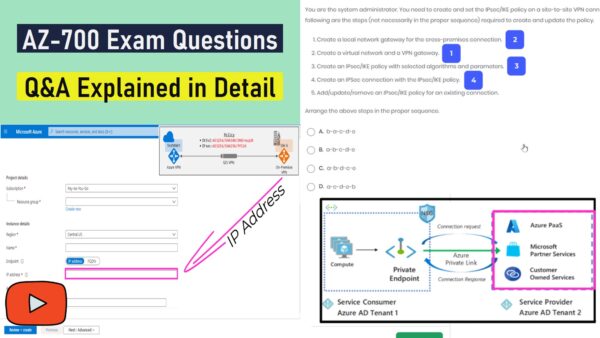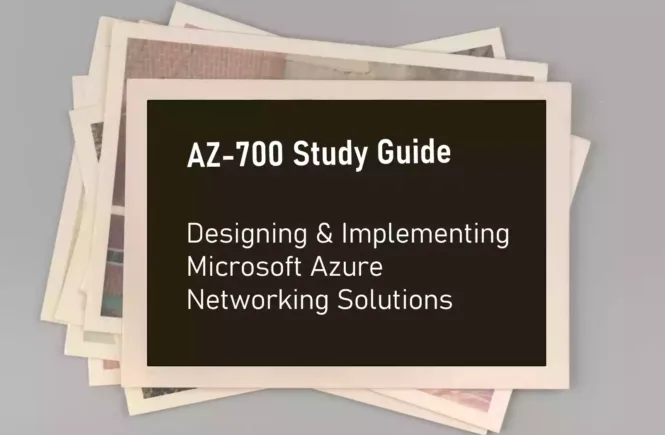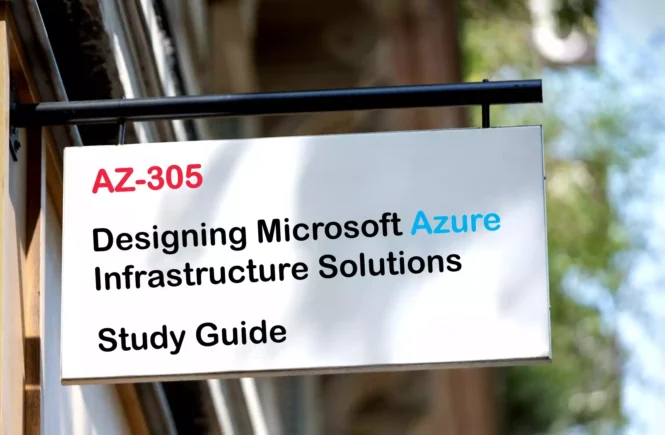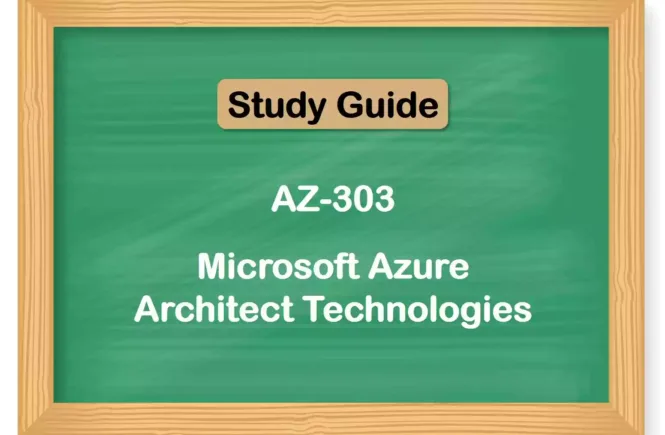AZ-700 Preparation Details
Preparing for the AZ-700 Designing and implementing Microsoft Azure Networking solutions exam? Don’t know where to start? This post is the AZ-700 Certificate Study Guide (with links to each exam objective).
I have curated a list of articles from Microsoft documentation for each objective of the AZ-700 exam. Please share the post within your circles so it helps them to prepare for the exam.
Exam Voucher for AZ-700 with 1 Retake
Get 40% OFF with the combo
AZ-700 Design Azure Virtual Networking Prep
| Pluralsight | Design & Implement Azure Network Solutions |
| LinkedIn Learning (Free trial) | Design a Networking Strategy for Architects |
| Udemy | Implementing Azure Networking Exam |
AZ-700 Implement Azure Networks Practice Test
| Whizlabs Exam Questions | Design networking solutions practice test |
| Udemy Practice Test | Implementing Azure Networking exam Q&A |
| Amazon e-book (PDF) | Azure networking cookbook (2nd edition) |
AZ-700 Sample Practice Exam Questions

Looking for AZ-700 Dumps? Read This!
Using az-700 exam dumps can get you permanently banned from taking any future Microsoft certificate exam. Read the FAQ page for more information. However, I strongly suggest you validate your understanding with practice questions.
Check out all the other Azure certificate study guides
Full Disclosure: Some of the links in this post are affiliate links. I receive a commission when you purchase through them.
Design, Implement, and Manage Hybrid Networking (10–15%)
Design, Implement, and Manage a Site-to-site VPN Connection
Design a site-to-site VPN connection for high availability
Highly available S2S VPN connections
Select an appropriate virtual network (VNet) gateway SKU
Identify when to use policy-based VPN versus route-based VPN
About policy-based and route-based VPN gateways
Create and configure a local network gateway
Create a local network gateway
Create and configure an IPsec/IKE policy
Azure Portal: Configure IPsec/IKE policy
Azure PowerShell: Configure IPsec/IKE policy
Create and configure a virtual network gateway
Create and manage a VPN gateway using the Azure portal
Diagnose and resolve VPN gateway connectivity issues
Troubleshooting an Azure site-to-site VPN connection
Diagnose on-premises connectivity via VPN gateways
Design, Implement, and Manage a Point-to-site VPN Connection
Select an appropriate virtual network gateway SKU
Plan and configure RADIUS authentication
Configure a P2S connection to a VNet using RADIUS
Plan and configure certificate-based authentication
Configure a P2S connection using certificates
Plan and configure OpenVPN authentication
Configure OpenVPN for P2S VPN gateways
Plan and configure Azure Active Directory (Azure AD) authentication
Create an Azure AD tenant for P2S connections
Implement a VPN client configuration file
Install VPN client configuration files for P2S RADIUS authentication
VPN client config files for P2S certificate authentication
Diagnose and resolve client-side and authentication issues
Troubleshoot Azure P2S connection problems
Troubleshoot an Azure AD authentication VPN client
Design, Implement, and Manage Azure ExpressRoute
Choose between provider and direct model (ExpressRoute Direct)
ExpressRoute using a service provider & Direct
Design and implement Azure cross-region connectivity between multiple ExpressRoute locations
Select an appropriate ExpressRoute SKU and tier
Design and implement ExpressRoute Global Reach
Configure ExpressRoute Global Reach
Design and implement ExpressRoute FastPath
Configure ExpressRoute FastPath
Choose between private peering only, Microsoft peering only, or both
Configure private peering
Configure an S2S connection over ExpressRoute private peering
Configure Microsoft peering
Configure an S2S VPN over ExpressRoute Microsoft peering
Create and configure an ExpressRoute gateway
About ExpressRoute virtual network gateways
Configure a VNet gateway for ExpressRoute
Connect a virtual network to an ExpressRoute circuit
Link a VNet to an ExpressRoute circuit
Recommend a route advertisement configuration
Configure encryption over ExpressRoute
ExpressRoute encryption: IPsec over ExpressRoute for Virtual WAN
Implement Bidirectional Forwarding Detection
Configure BFD over ExpressRoute
Diagnose and resolve ExpressRoute connection issues
Troubleshooting network performance
Design and Implement Core Networking Infrastructure (20–25%)
Design and Implement Private IP Addressing for VNets
Create a VNet
Plan and configure subnetting for services, including VNet gateways, private endpoints, firewalls, application gateways, and VNet-integrated platform services
Configure Azure VNet subnets with CIDR notation
Application Gateway infrastructure configuration
Plan and configure subnet delegation
Design and Implement Name Resolution
Design public DNS zones
Design a hybrid DNS solution with Azure
Design private DNS zones
What is a private Azure DNS zone?
Design name resolution inside a VNet
Name resolution for resources in Azure VNet
Configure a public or private DNS zone
Create a public Azure DNS zone
Create an Azure private DNS zone
Link a private DNS zone to a VNet
Link a private DNS Zone to VNet
Design and Implement Cross-VNet Connectivity
Design service chaining, including gateway transit
Service Chaining and VNET demo
Design VPN connectivity between VNets
Configure a VNet-to-VNet VPN gateway connection
Implement VNet peering
Create a virtual network peering
Design and Implement an Azure Virtual WAN Architecture
Design an Azure Virtual WAN architecture, including selecting SKUs and services
Azure Virtual WAN architecture
Connect a VNet gateway to Azure Virtual WAN
Connect a VPN Gateway to Virtual WAN
Create a hub in Virtual WAN
Create a network virtual appliance (NVA) in a virtual hub
About Network Virtual Appliance
Create an NVA in an Azure Virtual WAN hub
Configure virtual hub routing
How to configure virtual hub routing?
Create a connection unit
Amazon link (affiliate)
Design and Implement Routing (25–30%)
Design, Implement, and Manage VNet Routing
Design and implement user-defined routes (UDRs)
Create a user-defined route table with routes & an NVA
Associate a Route table with a subnet
Associate a Route table to a subnet
Configure forced tunneling
Configure forced tunneling for S2S connections
Diagnose and resolve routing issues
Diagnose a VM network routing problem
Diagnose a virtual machine routing problem
Design and Implement an Azure Load Balancer
Choose an Azure Load Balancer SKU (Basic versus Standard)
Choose between public and internal
Public vs. internal load balancer
Create and configure an Azure Load Balancer (including cross-region)
Create a cross-region Azure Load Balancer
Implement a load balancing rule
Create and configure inbound NAT rules
Create an inbound NAT port-forwarding rule
Create explicit outbound rules for a load balancer
Outbound rules Azure Load Balancer
Create outbound rule configuration
Design and Implement Azure Application Gateway
Recommend Azure Application Gateway deployment options
Azure Portal: Azure Application Gateway
PowerShell: Azure Application Gateway
CLI: Azure Application Gateway
ARM template: Azure Application Gateway
Choose between manual and autoscale
Create a back-end pool
Configure health probes
Create health probe for Application Gateway
Configure listeners
Application Gateway listener configuration
Configure routing rules
Application Gateway request routing rules
Configure HTTP settings
Application Gateway HTTP settings configuration
Configure Transport Layer Security (TLS)
Configure end to end TLS by using Application Gateway
Configure rewrite policies
Rewrite URL with Azure Application Gateway
Implement Azure Front Door
Choose an Azure Front Door SKU
Overview of Azure Front Door SKU
Configure health probes, including customization of HTTP response codes
Health probes for Azure Front Door
Configure SSL termination and end-to-end SSL encryption
Configure HTTPS on a Front Door custom domain
Configure multisite listeners
Application Gateway multiple site hosting
Configure back-end targets
Backends & backend pools in Azure Front Door
Configure routing rules, including redirection rules
How requests are matched to a routing rule?
Implement an Azure Traffic Manager Profile
Configure a routing method (mode)
Traffic Manager routing methods
Configure priority traffic routing method
Configure endpoints
Create HTTP settings
Design and Implement an Azure Virtual Network NAT
Choose when to use a Virtual Network NAT
Allocate public IP or public IP prefixes for a NAT gateway
Design VNets with NAT gateway resources
Associate a Virtual Network NAT with a subnet
Secure and Monitor Networks (15–20%)
Design, Implement, and Manage an Azure Firewall Deployment
Design an Azure Firewall deployment
Deploy & configure Azure Firewall
Create and implement an Azure Firewall deployment
Deploy & configure Azure Firewall & policy
Configure Azure Firewall rules
Configure Azure Firewall rules
Create and implement Azure Firewall Manager policies
Azure Firewall Manager policy overview
Create a secure hub by deploying Azure Firewall inside an Azure Virtual WAN hub
Configure Azure Firewall in a Virtual WAN hub
Secure your virtual hub using Firewall Manager
Integrate an Azure Virtual WAN hub with a third-party NVA
About NVA in an Azure Virtual WAN hub
Implement and Manage Network Security Groups (NSGs)
Create an NSG
Create a network security group
Associate an NSG to a resource
Associate network security group to subnet
Create an application security group (ASG)
Create application security groups
Associate an ASG to a NIC
Associate a Network Security Group to a NIC
Create and configure NSG rules
Interpret NSG flow logs
Validate NSG flow rules
Verify IP flow
Introduction to IP flow verify
Troubleshoot NSG configuration using IP Flow Verify
Implement a Web Application Firewall (WAF) Deployment
Configure detection or prevention mode
Configure rule sets for Azure Front Door, including Microsoft managed and user-defined
Web Application Firewall DRS rule groups
Custom rules for WAF with Azure Front Door
Configure rule sets for Application Gateway, including Microsoft managed and user-defined
Custom rules for WAF on Azure Application Gateway
Create WAF custom rules on Application Gateway
Implement a WAF policy
Create WAF policies for Application Gateway
Associate a WAF policy
Associate a WAF policy with an Application Gateway
Monitor Networks
Configure network health alerts and logging by using Azure Monitor
Create and configure a Connection Monitor instance
Create a monitor in Connection Monitor
Configure and use Traffic Analytics
Configure NSG flow logs
Enable and configure diagnostic logging
Configure Azure Network Watcher
Create an Azure Network Watcher instance
Design and Implement Private Access to Azure Services (10–15%)
Design and Implement Azure Private Link Service and Azure Private Endpoint
Create a Private Link service
Portal: Create a Private Link service
Plan private endpoints
What is Azure Private Endpoint?
Create private endpoints
Configure access to private endpoints
Integrate Private Link with DNS
Private Link & DNS integration at scale
Integrate a Private Link service with on-premises clients
Connect to Azure SQL server using an Azure Private Endpoint
Design and Implement Service Endpoints
Create service endpoints
Restrict access to PaaS resources with service endpoints
Configure service endpoint policies
Create service endpoint policy
Configure service tags
Configure access to service endpoints
Allow access to services from specific networks
Configure VNet Integration for Dedicated Platform as a Service (PaaS) Services
Configure App Service for regional VNet integration
Integrate your app with an Azure VNet
Configure Azure Kubernetes Service (AKS) for regional VNet integration
Configure clients to access App Service Environment
This brings us to the end of the AZ-700 Designing and implementing Microsoft Azure Networking solutions exam study guide.
What do you think? Let me know in the comments section if I have missed out on anything. Also, I love to hear from you how your preparation is going on!
In case you are preparing for other Azure certification exams, check out the Azure study guide for those exams.
Follow Me to Receive Updates on AZ-700 Exam
Want to be notified as soon as I post? Subscribe to the RSS feed / leave your email address in the subscribe section. Share the article to your social networks with the below links so it can benefit others.





